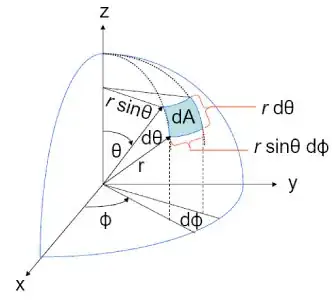Your problem is most likely in coding. Maybe [StackOverflow] would be a better suit for this question.
In any case, I tried numerical a quick Fortran example with the following results
Spherical Surface Integral ( 100 , 100 )
Expect: 12.5663706143592 ( 4.00000000000000 pi)
Actual: 12.5668874005135 ( 4.00016449814196 pi)
The full program below uses the f_inv_sq(r,u,v) function to return $f(r,u,v)=\tfrac{1}{r^2}$ and S_integral_spherical(f,r,n,m) to do the numerical integration of function f(r,u,v) over the surface of a sphere using n and m subdivisions of the angles.
program FortranConsole2
use, intrinsic :: iso_fortran_env
implicit none
integer, parameter :: wp = real64
interface
function V_scalar(r,u,v) result(f)
import
real(wp), intent(in) :: r,u,v
real(wp) :: f
end function
end interface
real(wp), parameter :: pi = acos(-1.0d0)
! Variables
real(wp) :: r, f, f_expect
integer :: n,m
r = 2.0_wp
n = 100
m = 100
print *, "Spherical Surface Integral (",n,",",m,")"
f_expect = 4*pi
f = S_integral_spherical(f_inv_sq, r, n, m)
print *, "Expect: ", f_expect, "(", f_expect/pi,"pi)"
print *, "Actual: ", f, "(", f/pi,"pi)"
contains
function S_integral_spherical(f,r,n,m) result(s)
real(wp) :: s
procedure(V_scalar),intent(in),pointer :: f
real(wp), intent(in) :: r
integer, intent(in) :: n,m
integer :: i,j
real(wp) :: ds, u, v, du, dv
s = 0.0_wp
du = (2*pi)/n
dv = (pi)/m
do i=1, n
u = (i-0.5_wp)*du
do j=1, m
v = (j-0.5_wp)*dv
ds = r**2*sin(v)*du*dv
s = s + f(r,u,v)*ds
end do
end do
end function
function f_inv_sq(r,u,v) result(f)
real(wp), intent(in) :: r,u,v
real(wp) :: f
f = 1/r**2
end function
end program
The crux of the above is the double loop for i and j inside, which accumulates the surface integral value s using
ds = r**2 * sin(v) * du * dv
s = s + f(r,u,v) * ds
where v represents the angle $\theta$ in your post, and u the angle $\varphi$.
or mathematically
$$ {\rm d}s = r^2 \sin \theta\,{\rm d}\theta\,{\rm d}\varphi $$
$$ s = \int f(r,\varphi,\theta)\,{\rm d}s$$
